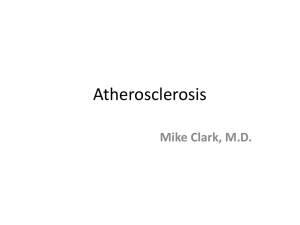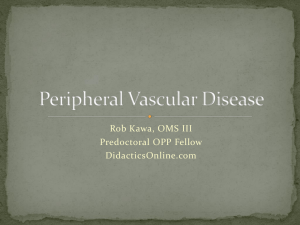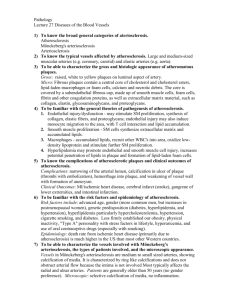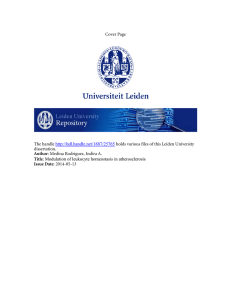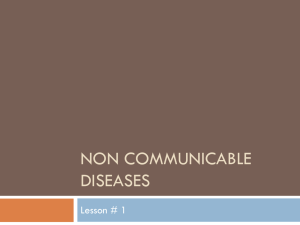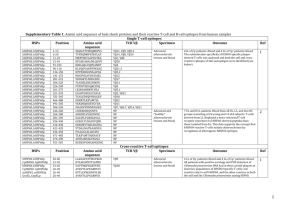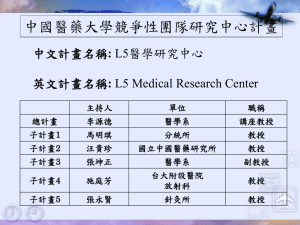Atherosclerosis article
advertisement
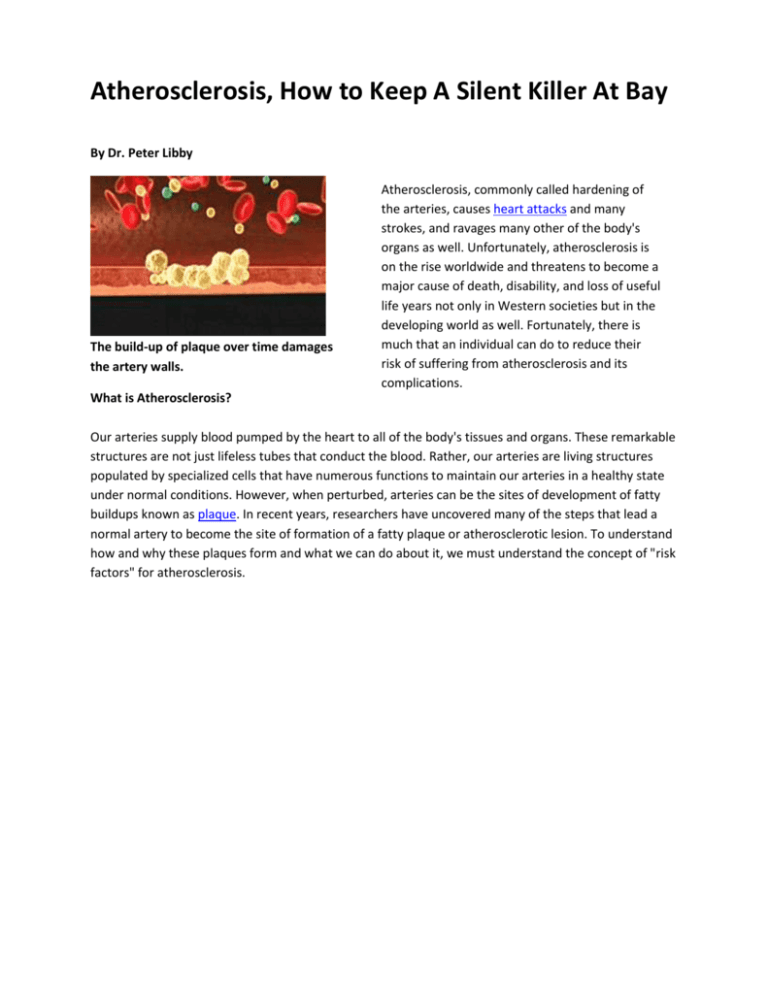
Atherosclerosis, How to Keep A Silent Killer At Bay By Dr. Peter Libby The build-up of plaque over time damages the artery walls. Atherosclerosis, commonly called hardening of the arteries, causes heart attacks and many strokes, and ravages many other of the body's organs as well. Unfortunately, atherosclerosis is on the rise worldwide and threatens to become a major cause of death, disability, and loss of useful life years not only in Western societies but in the developing world as well. Fortunately, there is much that an individual can do to reduce their risk of suffering from atherosclerosis and its complications. What is Atherosclerosis? Our arteries supply blood pumped by the heart to all of the body's tissues and organs. These remarkable structures are not just lifeless tubes that conduct the blood. Rather, our arteries are living structures populated by specialized cells that have numerous functions to maintain our arteries in a healthy state under normal conditions. However, when perturbed, arteries can be the sites of development of fatty buildups known as plaque. In recent years, researchers have uncovered many of the steps that lead a normal artery to become the site of formation of a fatty plaque or atherosclerotic lesion. To understand how and why these plaques form and what we can do about it, we must understand the concept of "risk factors" for atherosclerosis. "Risk Factors" for Atherosclerosis Careful observation of large populations has uncovered a number of "risk factors" for atherosclerosis that predict plaque development and the complications that they cause, such as heart attack and stroke. When the doctor measures your blood pressure, he gains important information about your risk for artery disease Atherosclerotic lesions are like pimples that form in artery walls. High blood pressure - The higher the blood pressure, the more likely an individual will develop fatty plaques and their complications. Cholesterol measurements in the blood similarly correlate with cardiovascular risk. Cholesterol - The higher an individual's level of cholesterol, particularly when carried in small "packages" known as "bad cholesterol,' or low-density lipoprotein (LDL) particles, the higher one's risk for a heart attack. Cigarettes - Cigarette smoking not only damages the lungs, but makes an individual more susceptible to atherosclerosis. Diabetes - People with diabetes have an accentuated risk for atherosclerosis. Doctors have called these easily measured indexes "risk factors" because of their ability to predict future cardiovascular complications. Fortunately, the risk factors listed above can be avoided or modified. For example, one can stop smoking tobacco, treat high blood pressure, and manage diabetes. However, certain risk factors for atherosclerosis cannot be modified, including age, sex, and one's genetic makeup as reflected by a family history of atherosclerosis. The risk is particularly high for people whose close relatives, such as parents or siblings, developed atherosclerosis at a relatively young age. Men tend to develop atherosclerosis at younger ages than women, but after menopause women tend to quickly "catch up" with men. Indeed, atherosclerosis is a major cause of death and heart attack in women. Atherosclerosis, How To Keep A Silent Killer At Bay In addition to these well-established risk factors for atherosclerosis, a number of newer markers of disease have caused considerable interest. However, we can go a long way to determining our risk for heart attack or stroke based on the simple measures described above. Emerging blood tests and imaging techniques may join the traditional tests described above in future years, but most will require more testing before adoption in routine practice. How Do Risk Factors Cause Atherosclerosis? Recent research findings have uncovered a new theory that links risk factors for atherosclerosis with fatty lesion formation and their complications such as heart attacks. When the function of the cells that make up the artery wall is perturbed by risk factors such as high levels of bad cholesterol, high blood pressure, cigarette smoke, or diabetes, it triggers a response similar to the body's reaction to foreign bodies or germs such as bacteria or viruses. White blood cells, the same cells the body uses to combat infections, accumulate in arteries that have encountered risk factors. These visitors to the artery wall lead to metabolic mayhem that disturbs the normal architecture of the artery and sets the stage for accumulation of atherosclerotic plaques. Smoking cigarettes puts you at higher risk for atherosclerosis. We used to conceive of atherosclerotic plaques as collections of fat droplets in the artery wall. We now know that this view is highly over-simplified. Much more than a depot of waxy grease, the atherosclerotic plaque teems with inflammatory cells. In this way, the atherosclerotic plaque can be viewed as an internal pimple or abscess in the artery wall, not caused by bacteria but rather by the risk factors listed above. As this internal pimple progresses, it can rupture, akin to the bursting of a boil or a pimple on the skin. This disruption of the fatty plaque due to the inflammation process can cause a blood clot to form, suddenly stopping blood flow and leading to a heart attack or stroke. This inflammatory theory of atherosclerosis provides our best current concept of how risk factors link to the clinical complications of this disease, such as heart attacks. How Can You Lower Your Risk of Atherosclerosis? Certainly we cannot choose our parents or slow down the march of years, and thus influence the nonmodifiable risk factors for atherosclerosis. However, we can do a great deal to reduce our risk of atherosclerosis, first and foremost by adopting a healthy lifestyle. Avoiding being overweight -- by following a prudent diet and incorporating physical activity into our daily lives -- can go a long way toward lessening a number of atherosclerotic risk factors, including disorders of the blood fats, development of diabetes or pre-diabetes, and the onset or aggravation of high blood pressure. Never smoking, or stopping if you do, can drastically lower risk of atherosclerotic complications. Unfortunately, a healthy lifestyle by itself often does not suffice to achieve optimum protection from atherosclerosis and its complications. Therefore, we are lucky to have a number of treatments today that can reduce atherosclerotic risk. Depending on levels of cholesterol and the kinds of cholesterol carriers in our blood, blood pressure and blood sugar levels, and other risk factors, doctors can today tailor a regimen of risk-modifying medications that can go a long way toward reducing an individual's atherosclerotic risk. Added to a foundation of lifestyle change, medications both over the counter and prescription have been proven effective in reducing risk of atherosclerosis. In individuals with a certain level of risk for atherosclerotic events, a baby aspirin a day can markedly lower the risk of cardiovascular events. For those in whom a healthy lifestyle alone can't control blood pressure or the blood fats, doctors can prescribe medications that address specific risk factors. (Curiously, antioxidant vitamins such as vitamins E and C and beta-carotene, do not seem to lower atherosclerotic risk.) Thus, by a combination of healthy living and, when required, the addition of specific drug therapies, we can successfully manage atherosclerotic risk in many individuals. In the case of Beth Bradley, featured in THE MYSTERIOUS HUMAN HEART's "Endlessly Beating" episode, her family history of early atherosclerotic disease indicated that she herself had a heightened cardiovascular risk, despite being a relatively young woman. Individuals in this situation should have particular vigilance about adhering to a healthy lifestyle and should In the case of Bob Cunningham, also featured in THEwith MYSTERIOUS HUMAN HEART's work their doctors to assess their"Endlessly Beating" episode, he suffered multiple heart attacks without even knowing it, amanage not uncommon scenario. These cardiovascular risk and it intensely. heart attacks left him with a severely injured heart that necessitated the dramatic, costly, and challenging heart transplantation that ultimately saved his life and returned him to a high degree of function. If Bob had managed his risk factors optimally in the decades preceding his development of a severely weakened heart muscle, the need for transplantation might have been delayed or avoided altogether. The best protection against atherosclerotic risk is prevention. The cornerstone of prevention is a healthy lifestyle. Working with your healthcare provider to assess your cardiovascular risk and manage it according to our current guidelines is the best way to lower your risk of suffering from this growing epidemic of atherosclerosis.
